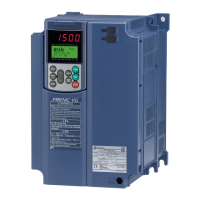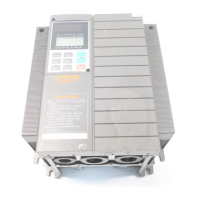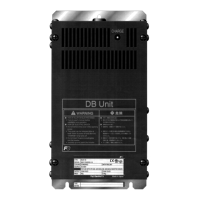Curve acceleration/
deceleration
Action
Function
code
0
Disable (Linear
acceleration/deceleration)
Acceleration/deceleration with constant acceleration. -
1
S-curve
acceleration/deceleration
(Weak)
Smoothen the speed change
and reduce shock when
starting acceleration and right
before the speed becomes
constant, as well as when
starting deceleration and right
before the deceleration stops.
Weak: Fix acceleration/deceleration
change rate to 5% of the maximum output
frequency within each S-curve range.
-
2
S-curve
acceleration/deceleration
(Arbitrary)
Arbitrary: It is possible to set
acceleration/deceleration change rate
arbitrarily within each S-curve range.
H57, H58
H59, H60
3
Curve
acceleration/deceleration
Linear acceleration/deceleration (constant torque) at or below base
frequency and acceleration becomes gradually slower at or higher than
the base frequency, and acceleration/deceleration with constant load rate
(rated output). It is possible to accelerate/decelerate with the maximum
capability.
-
S-curve acceleration/deceleration
For the purpose of decreasing the shock on the load machine side, smoothen the speed change at the start of
acceleration and right before it becomes constant speed, and at the start of deceleration and right before the stop
of deceleration. As for s-curve acceleration/deceleration values, fix with 5% for S-curve acceleration/deceleration
(weak), and for S-curve acceleration/deceleration (arbitrary), it is possible to set individually for each 4 locations by
function codes H57 to 60. The specified acceleration/deceleration time determines acceleration of linear part and
the actual acceleration/deceleration time becomes longer than the specified acceleration /deceleration time.
At the start of
acceleration
At the end of
acceleration
At the start of
deceleration
At the end of
deceleration
S-curve (Weak) 5% 5% 5% 5%
S-curve (Arbitrary)
Setting range:
0 to 100%
H57
At acceleration
No. 1 S-curve range
(At starting)
H58
At acceleration
No. 2 S-curve range
(At arrival)
H59
At deceleration
No. 1 S-curve range
(At starting)
H60
At acceleration
No. 2 S-curve range
(At the arrival)
Acceleration/Deceleration time
< S-curve acceleration/deceleration (Weak): When frequency change is 10% or higher than the maximum
frequency>
Acceleration or deceleration time (s) = (2 × 5/100 + 90/100+ 2 × 5/100) × reference acceleration or
deceleration time
= 1.1 × reference acceleration or deceleration time
< S-curve acceleration/deceleration (Arbitrary: When 10% at the start, 20% at the end): When frequency change is
30% or higher than the maximum frequency.>
Acceleration or deceleration time (s) = (2 × 10/100 + 70/100 + 2 × 20/100) × (reference acceleration or
deceleration time)
= 1.3 × (reference acceleration or deceleration time)

